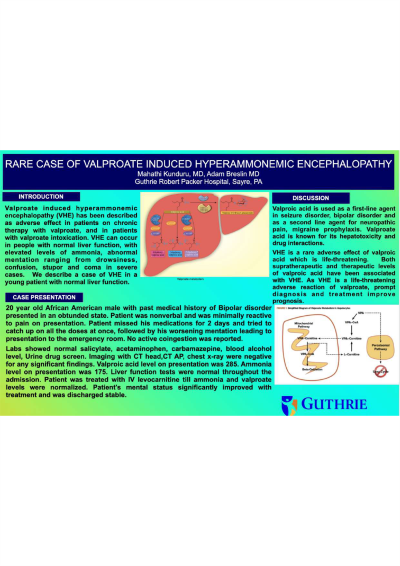Tuesday Poster Session
Category: Liver
P4836 - Rare Case of Valproate-Induced Hyperammonemic Encephalopathy
Tuesday, October 29, 2024
10:30 AM - 4:00 PM ET
Location: Exhibit Hall E

Has Audio

Mahathi Kunduru, MD (she/her/hers)
Guthrie Robert Packer Hospital
Sayre, PA
Presenting Author(s)
Mahathi Kunduru, MD, Shobha Mandal, MD
Guthrie Robert Packer Hospital, Sayre, PA
Introduction: Valproate induced hyperammonemic encephalopathy (VHE) has been described as adverse effect in patients on chronic therapy with valproate, and in acute valproate intoxication. VHE can occur in people with normal liver function, with elevated levels of ammonia, abnormal mentation ranging from drowsiness, confusion, stupor and coma in severe cases. We describe a case of VHE in a young patient with normal liver function.
Case Description/Methods: 20-y.o. male with PMH of Bipolar disorder, polysubstance abuse presented to the emergency room in an obtunded state.Patient was nonverbal and was minimally reactive to pain on presentation. As per history obtained from patient's friend, patient missed his medications for 2 days and tried to catch up on all the doses at once, followed by his worsening mentation leading to presentation to the emergency room. No active coingestion was reported. Labs showed normal salicylate, acetaminophen, carbamazepine, blood alcohol level, urine drug screen. Imaging with CT head,CTAP were negative for any significant findings. Valproic acid level on presentation was 285. Ammonia level on presentation was 175. Liver function tests were normal throughout the admission. Patient was treated with IV levocarnitine till ammonia and valproate levels were normalized. Patient's mental status significantly improved with treatment and was discharged stable.
Discussion: Valproic acid is used as a first-line agent in seizure disorder, bipolar disorder and as a second line agent for neuropathic pain, migraine prophylaxis. VHE is a rare adverse effect of valproic acid which is life-threatening.Valproate is primarily metabolized in the liver via gluconate conjugation and beta oxidation. Valproate inhibits the activity of carbamoyl phosphate synthetase 1(CPS1), which inhibits the progression of urea cycle and therefore resulting elevated ammonia levels. Valproate depletes the level of carnitine by enhancing its renal excretion.Carnitine is essential for fatty acid oxidation in the mitochondria, acetylcoA production and synthesis of N acetyl glutamic acid which is required for activation of CPS.Discontinuation of valproate and L-carnitine supplementation forms the primary therapy. L-carnitine promotes ammonia excretion, decreases alternate metabolism of valproic acid thereby decreasing the toxic metabolite production. As VHE is a life-threatening adverse reaction of valproate, prompt diagnosis and treatment improve prognosis.
Note: The table for this abstract can be viewed in the ePoster Gallery section of the ACG 2024 ePoster Site or in The American Journal of Gastroenterology's abstract supplement issue, both of which will be available starting October 27, 2024.
Disclosures:
Mahathi Kunduru, MD, Shobha Mandal, MD. P4836 - Rare Case of Valproate-Induced Hyperammonemic Encephalopathy, ACG 2024 Annual Scientific Meeting Abstracts. Philadelphia, PA: American College of Gastroenterology.
Guthrie Robert Packer Hospital, Sayre, PA
Introduction: Valproate induced hyperammonemic encephalopathy (VHE) has been described as adverse effect in patients on chronic therapy with valproate, and in acute valproate intoxication. VHE can occur in people with normal liver function, with elevated levels of ammonia, abnormal mentation ranging from drowsiness, confusion, stupor and coma in severe cases. We describe a case of VHE in a young patient with normal liver function.
Case Description/Methods: 20-y.o. male with PMH of Bipolar disorder, polysubstance abuse presented to the emergency room in an obtunded state.Patient was nonverbal and was minimally reactive to pain on presentation. As per history obtained from patient's friend, patient missed his medications for 2 days and tried to catch up on all the doses at once, followed by his worsening mentation leading to presentation to the emergency room. No active coingestion was reported. Labs showed normal salicylate, acetaminophen, carbamazepine, blood alcohol level, urine drug screen. Imaging with CT head,CTAP were negative for any significant findings. Valproic acid level on presentation was 285. Ammonia level on presentation was 175. Liver function tests were normal throughout the admission. Patient was treated with IV levocarnitine till ammonia and valproate levels were normalized. Patient's mental status significantly improved with treatment and was discharged stable.
Discussion: Valproic acid is used as a first-line agent in seizure disorder, bipolar disorder and as a second line agent for neuropathic pain, migraine prophylaxis. VHE is a rare adverse effect of valproic acid which is life-threatening.Valproate is primarily metabolized in the liver via gluconate conjugation and beta oxidation. Valproate inhibits the activity of carbamoyl phosphate synthetase 1(CPS1), which inhibits the progression of urea cycle and therefore resulting elevated ammonia levels. Valproate depletes the level of carnitine by enhancing its renal excretion.Carnitine is essential for fatty acid oxidation in the mitochondria, acetylcoA production and synthesis of N acetyl glutamic acid which is required for activation of CPS.Discontinuation of valproate and L-carnitine supplementation forms the primary therapy. L-carnitine promotes ammonia excretion, decreases alternate metabolism of valproic acid thereby decreasing the toxic metabolite production. As VHE is a life-threatening adverse reaction of valproate, prompt diagnosis and treatment improve prognosis.
Note: The table for this abstract can be viewed in the ePoster Gallery section of the ACG 2024 ePoster Site or in The American Journal of Gastroenterology's abstract supplement issue, both of which will be available starting October 27, 2024.
Disclosures:
Mahathi Kunduru indicated no relevant financial relationships.
Shobha Mandal indicated no relevant financial relationships.
Mahathi Kunduru, MD, Shobha Mandal, MD. P4836 - Rare Case of Valproate-Induced Hyperammonemic Encephalopathy, ACG 2024 Annual Scientific Meeting Abstracts. Philadelphia, PA: American College of Gastroenterology.
